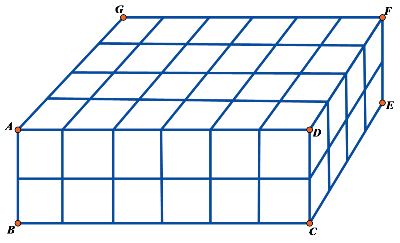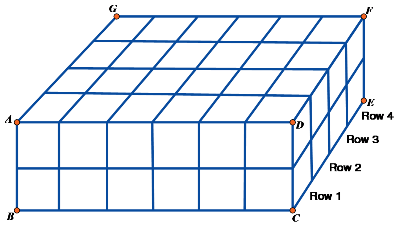Vocabulary
Face- the flat surface of a three-dimensional figure.
Edge- where two faces meet.
Polyhedron- a three-dimensional figure whose faces are all polygons.
Vertex- a point where three of more edges meet.
Base- the faces that is used to name the polyhedron.
Prism- a polyhedron that has two parallel, congruent bases.
Pyramid- a polyhedron that has one base.
Cylinder- has two parallel, congruent bases that are circles.
Cone- has one base that is a circle.
Sphere- has a surface made up of all points, that are the same distance from any given point.
Cross Section- when a three-dimensional figure and a plane intersect. The intersection is the cross
section.
Volume- the number of cubes a three-dimensional figure can hold.
Examples

The volume of a solid is the amount of space inside the object. It's how much water fits inside a bathtub, how much sand fills a bucket, or how much soda your
 friend can chug and hold in his stomach.
friend can chug and hold in his stomach.Take a look
 at this rectangular prism:
at this rectangular prism:
If we consider the front face (Rectangle ABCD) to be the base we can see that it has an area of 12 square units. There are four rows of this face, each with 12 cubes in it.

So, if we multiply the area of the face (12) by the 4 rows, we find that there are 48 cubes, or a volume of 48 cubic units!
Let's look at another type of prism: a cube! Here's a sample of the surface area and volume of a cube.

If the area of the circular base is equal to 16π square units, and there are five rows of these circular bases, then the volume would be 16π × 5 = 80π cubic units, or approximately 251.2 cubic units.
Look Out: volume is always cubic units (units3). This is because we are dealing with the three-dimensional objects now. You're in the big time!
This is pretty much all you have to do to find the volume of any prism or cylinder: find the area of the base and multiply it by the height.
Volume of a Prism or Cylinder = area of the Base x height
Volume = Bh
Look Out: note the difference between small "b" and large "B". In the examples above (and often in geometry in general), small "b" is the length of the base of a 2D shape. Large "B" is the area of the base of a 3D solid.
http://www.shmoop.com/basic-geometry/volume-prisms-cylinders.html
Video Help
https://www.youtube.com/watch?v=ORUIzPF8mtI
https://www.youtube.com/watch?v=qg8oQ47YxxA
https://www.youtube.com/watch?v=OYY4ZkhpqGU
No comments:
Post a Comment